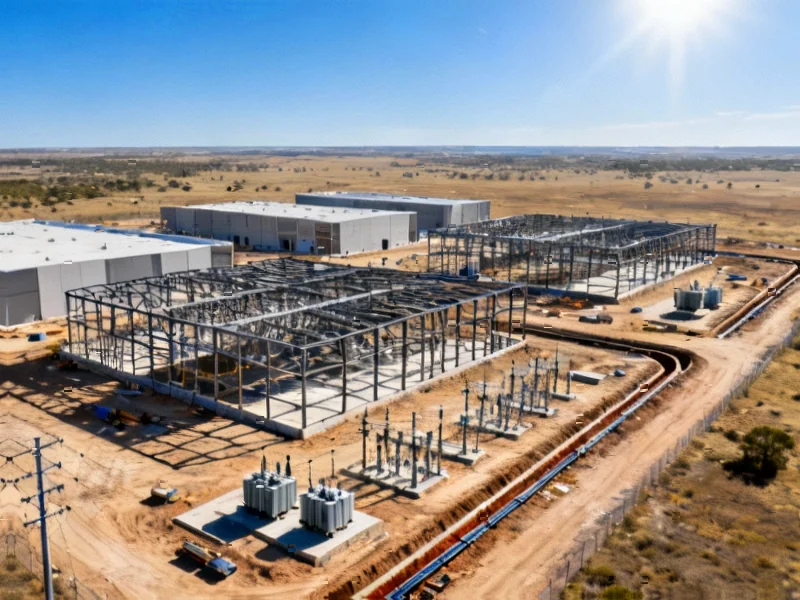According to DCD, TeraWulf has formed a joint venture with AI cloud firm Fluidstack to develop a 168MW data center campus in Abernathy, Texas, with Google backing approximately $1.3 billion of Fluidstack’s lease obligations. The 25-year hosting commitment represents $9.5 billion in contracted revenue, with TeraWulf holding a 51 percent majority stake in the venture. The facility is expected to be delivered in the second half of 2026 on a 120-acre campus, with the joint venture having rights to develop subsequent phases beyond the initial capacity. This marks the third deal between TeraWulf and Fluidstack backed by Google, following previous agreements for 360MW at TeraWulf’s Lake Mariner campus in New York. This pattern reveals Google’s strategic approach to securing AI infrastructure through innovative financing models.
Table of Contents
Google’s Infrastructure Gambit
What’s particularly revealing about this deal isn’t the scale—though 168MW is substantial—but Google’s financing structure. By backstopping Fluidstack’s lease obligations rather than directly building or owning the infrastructure, Google achieves several strategic objectives simultaneously. They secure guaranteed capacity for AI workloads without the capital expenditure of construction, maintain flexibility through termination options, and effectively control infrastructure without the operational burden. This represents a sophisticated evolution in how hyperscalers approach data center strategy, moving from ownership to strategic financing partnerships that provide both capacity assurance and financial protection.
TeraWulf’s Strategic Pivot
TeraWulf’s transformation from cryptocurrency mining to high-performance computing infrastructure provider represents one of the most successful pivots in the digital infrastructure space. Their ability to leverage existing energy expertise and development scale into contracted HPC capacity demonstrates remarkable strategic execution. With contracted capacity now exceeding 510MW and targeting another 250-500MW annually, TeraWulf has effectively positioned itself as a preferred infrastructure partner for AI workloads. The joint venture model allows them to share risk while maintaining majority control, creating a scalable platform for future growth.
Texas’ Emerging AI Corridor
The choice of Abernathy, Texas reflects broader trends in AI infrastructure geography. Located 22 miles north of Lubbock, this region offers several advantages beyond just cheap power—though that’s certainly a factor. The area provides access to multiple grid interconnections, lower cooling costs due to climate, and proximity to emerging technology hubs. We’re seeing the formation of a new AI infrastructure corridor in West Texas that could rival traditional data center markets. The 120-acre campus suggests planning for significant expansion beyond the initial 168MW, potentially creating an AI computing hub that could attract additional investment and talent to the region.
Risk Factors and Challenges
While the deal structure appears sophisticated, several risks deserve attention. The 25-year commitment represents an exceptionally long term in the rapidly evolving AI landscape—today’s GPU architectures may be obsolete within 5-7 years, raising questions about infrastructure adaptability. Google’s backstop arrangement, while providing financial security, creates significant concentration risk for both TeraWulf and Fluidstack. If AI demand doesn’t materialize as projected or if Google’s strategic priorities shift, the entire venture could face challenges. Additionally, the project financing through high-yield bonds exposes the venture to interest rate volatility and capital market conditions.
Industry Implications
This deal establishes a new template for AI infrastructure development that other hyperscalers will likely emulate. The model of partnering with specialized infrastructure providers while providing financial backing allows tech giants to scale capacity rapidly without the operational overhead of direct construction and management. We should expect to see similar structures emerging from Amazon, Microsoft, and other cloud providers seeking to secure GPU capacity for AI workloads. This also creates opportunities for infrastructure developers with energy expertise and scalable sites, particularly those who can demonstrate reliability and operational discipline to attract tier-1 partners.
Future Outlook
The repeated pattern of Google-backed deals between these companies—three separate agreements now—suggests this isn’t a one-off experiment but rather a proven model that’s scaling. With first refusal rights on Fluidstack’s next 168MW project and expansion rights at the Abernathy campus, TeraWulf has positioned itself for sustained growth. However, the real test will come in execution—delivering the campus on schedule in 2026 while maintaining the operational excellence that attracted Google’s backing. If successful, this model could become the dominant approach for AI infrastructure development through the remainder of the decade.



